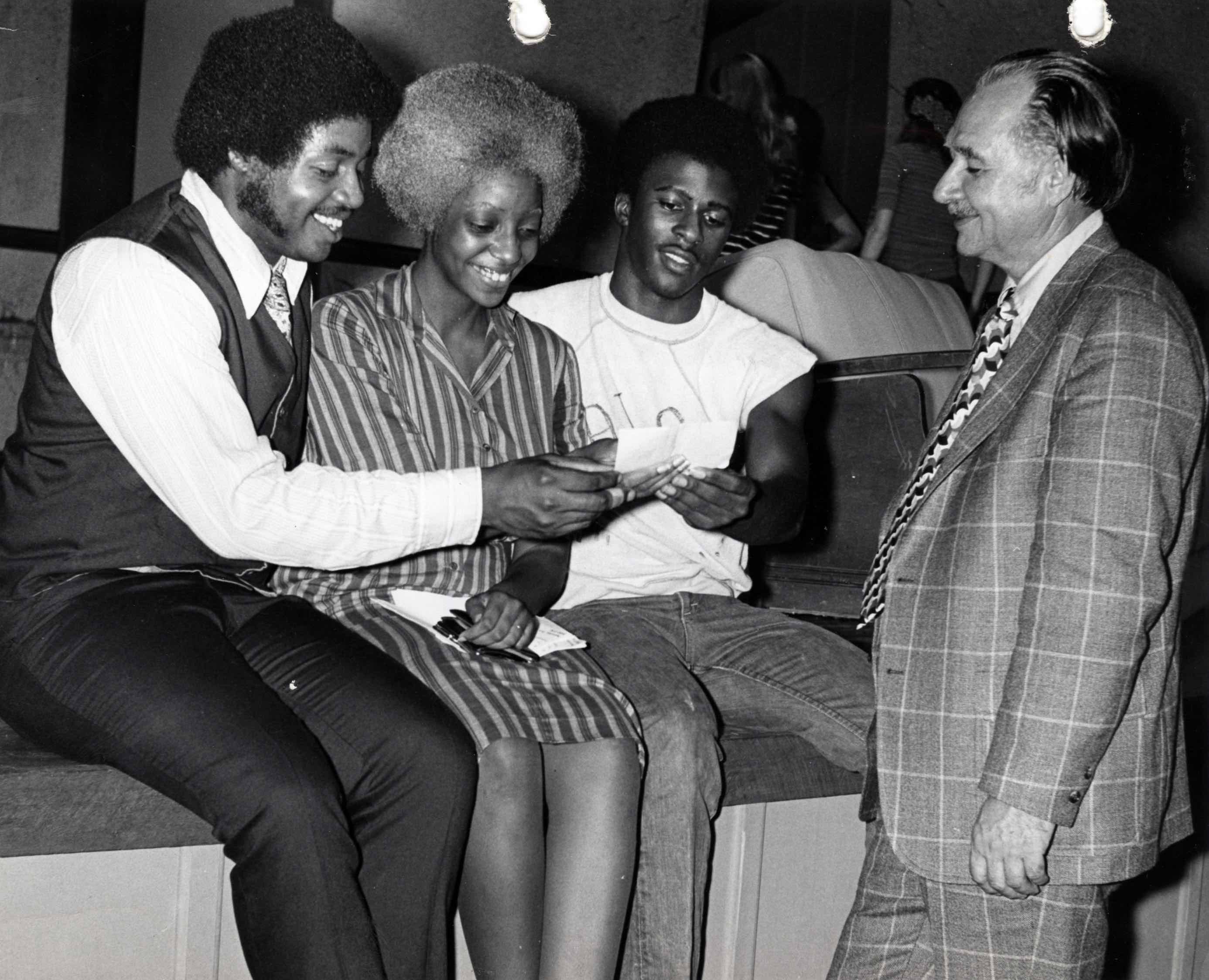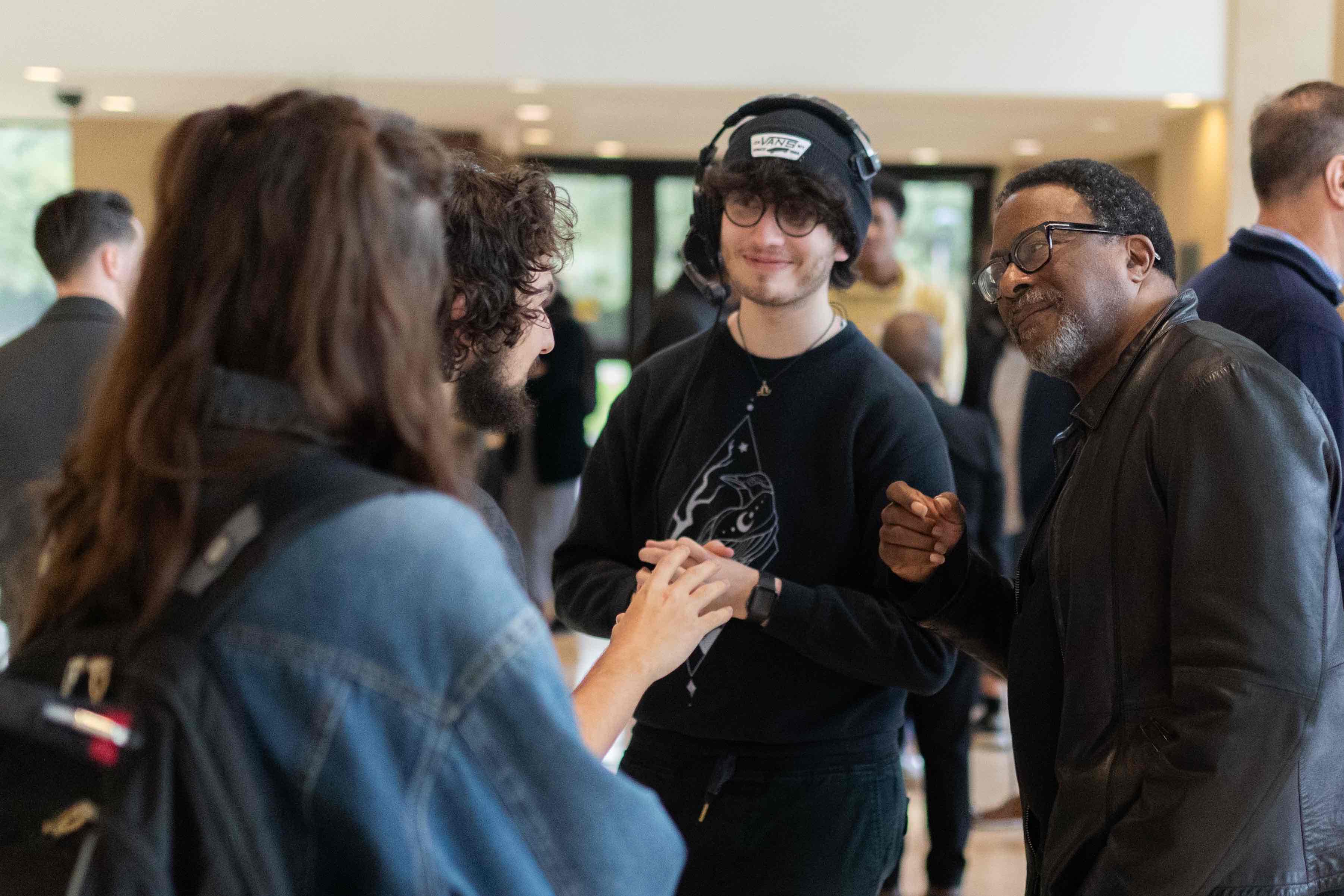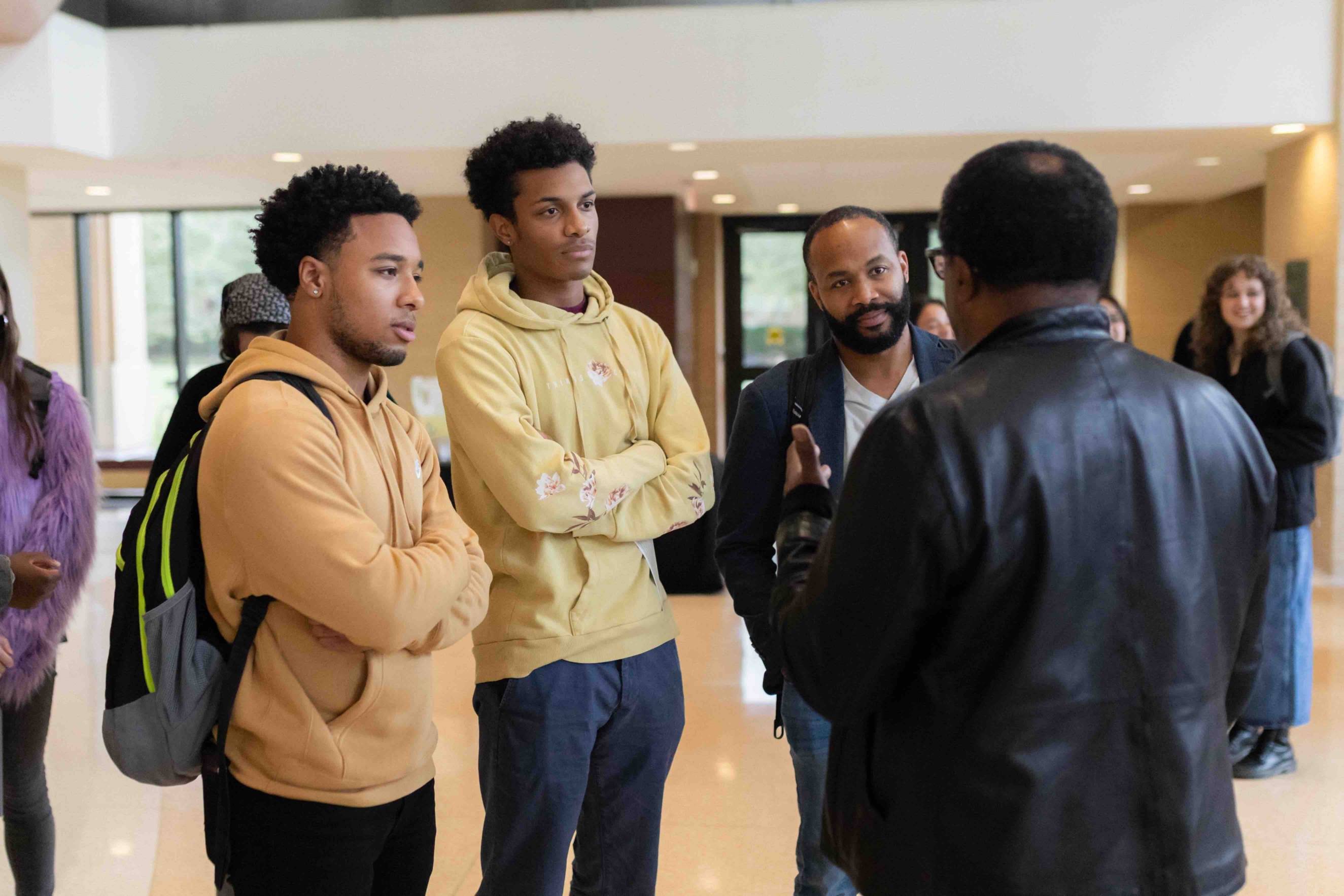Lane Fortenberry | January 17, 2024

Returning to your alma mater is sure to stir nostalgia of campus experiences. In the case of acclaimed TV and film director Thomas Carter, long days of reading lines of dialogue dominate his memories of being a student at Texas State University.
Carter, a 1974 graduate of the theatre program, returned to San Marcos for the first time in 20 years in November 2023 to participate in the College of Fine Arts and Communication Alumni Series’ inaugural “In Conversation With…” Q&A session.
Carter, who was honored as a distinguished alumnus in 1992, is a three-time Emmy winner and director of five feature films and more than 50 TV shows. A few of his TV directing career highlights include “Equal Justice,” “Hill Street Blues,” “Miami Vice,” and “The Morning Show.” Film directing career highlights include Save the Last Dance and Coach Carter.
He is also a recipient of the George Foster Peabody Award, Broadcast Film Critics Award, and Director’s Guild of America Award, and a three-time nominee for the NAACP Image Award for Outstanding Directing.
During his campus talk, Carter treated attendees to stories about his career. He discussed TV and movie clips and offered advice for theater and film students hoping to follow in his footsteps. He also reminisced about his time at what was then Southwest Texas State.
“Some of the buildings are still here, like the theater department and Old Main, obviously,” Carter said. “There are so many new structures that it's just been interesting to explore. There wasn't a film department, so it's great to see that start to develop. And, of course, there are personal memories of friends and growing up in classes that remained fresh in my mind when I walked through campus. The memory of all the influential faculty I learned from still looms large.”
Early days at TXST
Carter didn’t set out to be a director. Growing up in Smithville, he was constantly involved in performing arts, from giving holiday speeches and singing solos in church choir to acting in school plays.
After deciding to be an actor in high school, he applied and was accepted to The University of Texas at Austin, but he changed course due to a family recommendation.
“My mother, who was a teacher, recommended that I start here,” Carter said. “I think she was just concerned about the size of that university and was maybe a little less ambitious for me than I was for myself. There were many advantages to being here. The size of the university was very friendly. I had a lot of access in the theater department and made friends.”
During his time at TXST, Carter co-founded the Ebony Players, a Black theater group, with his college cohort and friend, Eugene Lee. They were inspired to form the group after the Dallas Theater Center visited campus for a performance of Douglas Turner Ward’s Day of Absence.
“It was kind of a revelation,” Carter said. “I hadn't really seen Black theater, but I read about what was going on in New York. It was a wonderful production, and they just did a great job. We were really mesmerized by that and wanted to do some productions of our own here at school.”
The Ebony Players most memorable show was a performance of A Raisin in the Sun at Lyndon B. Johnson State Park and Historic Site on July 22, 1972, for a crowd of almost 500 people, including former President Johnson and United Artists President Arthur Krim. LBJ presented the cast with a $1,000 check for the Ebony Players’ scholarship fund after the production.

Lee, also a distinguished alum, is an artist in residence at TXST’s Department of Theatre and Dance and director of the university’s Black and Latino Playwrights Celebration.
“We were also two of just a handful of Black theatre majors in the department, and they weren’t choosing plays that had a lot of inclusion or diversity,” Lee said. “The productions didn’t include opportunities for us who were Black characters. After a conversation with Department Chair James Barton, we settled on A Raisin in the Sun and eventually performed it on President Johnson’s ranch.”
A class assignment to direct a one-act play planted the first seeds of directing interest in Carter’s mind. When preparing for the play, he wasn’t sure if he would like it, but he developed a sense of confidence as he worked with the actors.
“I really had a clear idea of what I wanted from the actors and where they should move on the stage,” Carter said. “It was a very satisfying experience. It didn't transplant my desire primarily to be an actor, but it was the taste that I liked. Later when I came to do it, I had some comfort level from that previous experience.”
Starting an acting career in Los Angeles
Once he graduated, Carter took the $400 in his pocket and drove across the southwestern United States with his younger brother to California. There, he stayed with his older brother in Los Angeles and began pursuing an acting career.
Carter contacted an agent he’d met while at TXST who suggested he take a professional acting class. He was accepted into Jeff Corey’s acting class, whose students over the years had included Carol Burnett, James Coburn, James Dean, Jack Nicholson, Kirk Douglas, Barbara Streisand, Jane Fonda, Peter Fonda, and Bruce Lee, among others.
In just a short period, Carter landed a commercial and theatrical agent, received his Screen Actors Guild (SAG) card, and booked a pilot.
“There were a lot of people I met who were still waiting to get their SAG card, and that was always the rub,” he said. “You have to be in the union to get a job, you have to get a job to get in the union. It was always a catch 22.”

Carter also mailed his headshots and resume to list of casting directors at the different studios in hopes of setting up meetings. One of the casting directors he met was Terry Liebling, who told him about an upcoming pilot he might be a good fit for.
Carter followed up persistently and landed an audition with just a few hours’ notice.
“I rushed to get ready to go in,” Carter said. “I went there to audition on the set with the head casting director, Lynn Stallmaster, and the director. There were three of us in a lobby of this old bank building for two roles. Two would read and then they'd pair two others, and they would read. I thought, ‘This is kind of barbaric.’ They chose two, and I was one of them.”
Carter would go on to act in 15 different TV shows and movies, most notably as James Hayward in the 1978-1981 sports drama show “The White Shadow.” The series also gave him his first experiences behind the camera. As the director of four episodes, he called on his formative experiences at TXST.
Transitioning from actor to director
Carter credits the abundance of downtime in television acting for fueling his interest and curiosity how shows are put together. In between call times, he would watch directors work with actors, observe camera operators, and visit the screening room to watch dallies (raw footage from the day before).
“’The White Shadow’ was a formative experience because I became a director out of it,” Carter said. “I just didn’t have enough to do as an actor. I didn’t mind sharing the stage with the other actors, but I didn’t really enjoy coming to work every day and being part of what I was calling ‘choral acting’ because it was like we were a chorus if it wasn’t our episode.
“That led to Bruce [Paltrow] seeing what I was doing. He said if I really applied myself, maybe I could do an episode in the second season. That became a really concerted effort. He suggested I spend time in the editing room, which I then started to do. In the second season, I was given my first episode.”
Carter directed 13 pilots that were ultimately picked up by networks and ordered to series, including “Miami Vice.” When Carter signed on as director, he added music and montage, which weren’t in the script. A special highlight was the Phil Collins “In the Air Tonight” sequence.
In addition to his TV directing assignments, Carter began directing feature films, including 1993’s Swing Kidswith Christian Bale and 1997’s Metro with Eddie Murphy. This led to Paramount Pictures sending him the script of Save the Last Dance.
Carter brought on writer Cheryl Edwards to further develop the script, including fleshing out Kerry Washington’s character. The film follows an interracial romance in a predominately Black high school in the South Side of Chicago, and Carter paid concerted attention to the Black females who surrounded the main characters to ensure their stories were heard.

“I like social dramas, coming of age stories, music, and dance, so I was really interested in doing it,” Carter said. “Kerry played the sister of the male lead in the movie. She was a single teenage mom still in high school. In the original script, there was no looking inside to see what that meant. What is her life, what are those challenges, what are her fears, and will that be it for her? Cheryl and I really developed that story.
“It was great to be part of that transition [from TV] for Kerry. She was great because she was not only a wonderful actress, but she was also somebody I could use as a research asset because she was one generation younger. I could talk to her about culture and language when we were doing the movie.”
Made with a $13 million budget, the film grossed $131 million at the global box office when it was released in 2001.
On the heels of that success, Ken Carter, former basketball coach who maintained that his high school players take their studies as seriously as the sport, contacted the director in hopes he would direct his story for the big screen. Even though other producers beat him to the punch for the rights, Paramount Pictures approached him once again to helm the project.
Thomas Carter’s interest in the film stemmed from being raised by a family of educators. His mother was a home economics teacher, and both his aunts were teachers. The movie Coach Carter’s focus on education as much as basketball was a personal draw for him.
Whether directing TV shows or films, all projects first start with what’s on the page, Carter said.
“It’s all about the story,” Carter said. “You have to keep your mind and eye on telling the story and figuring out the best way to do that. There are always obstacles and challenges. With Coach Carter, I had a lot of things to deal with, including a veteran actor who came in with a lot of ego. I had to prepare to work with him in addition to working with middle-level actors and actors with no experience.
“As the director, you must always remember that at the end of the day, the audience is not going to know any of those behind-the-scenes things. They are only going to see the images and characters on screen.”
Carter continues to direct and develop TV and film projects, with his most recent being an episode of “The Morning Show” on Apple TV+.
Carter said the proliferation of streaming services has benefited directors with bigger budgets and more time to conceptualize projects compared to broadcast TV. Seasons of TV shows on a streaming network tend to include eight to 10 episodes rather than the 20 or more on broadcast television.
“It’s a lot of fun to do,” Carter said. “When you're doing less, you can take more time to write it, produce it, and direct it.”

A growing film community at TXST
Back in San Marcos, TXST is home to a growing film program. And with the next year’s planned opening of Hill Country Studios—a 200-acre film and television production hub that will be the largest in Texas—TXST students should benefit from valuable hands-on opportunities.
“It's going to be great for Texas and the university,” Carter said. “I have no doubt there will be access for students at Texas State to be much closer to professional filmmaking projects. It's going to be great for both students and as they graduate. Given the training I see happening now at Texas State, students are going to be more and more prepared to move into the professional industry.”
Carter credits his time at the university for shaping his career as an actor, director, and producer.
“I got a chance to be on stage and experience a lot of things,” Carter said. “There's more than just the theater department, though. I would say to learn everything you can while you're here, whatever your own interests are. Now is the time when you get to do those things.”
Watch the entire session for more stories and highlights about Carter’s career.
Share this article
For more information, contact University Communications:Jayme Blaschke, 512-245-2555 Sandy Pantlik, 512-245-2922 |
